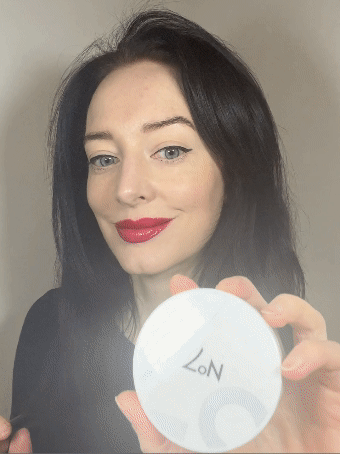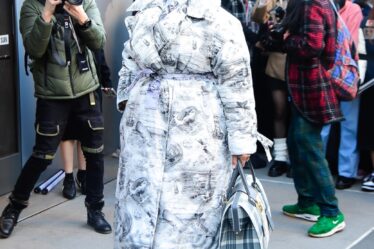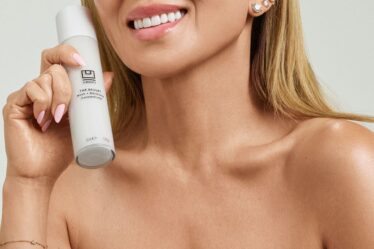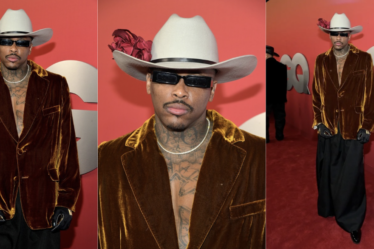
Key Ingredients: Vitamin E | Size: 0.21oz
- What We Love: Cruelty-free, gentle formula
- What We Don’t Like: Only available in one shade
Best Talc-Free: ILIA Soft Focus Finishing Powder
This loose powder from ILIA is designed to lock in your makeup while also providing your skin with a trio of hydrating and conditioning ingredients. The formula is talc-free so won’t result in flashback in photos and the cocktail of aloe, bamboo, and rosemary keep the skin soothed, soft, and supple. I love this setting powder because it is so finely milled that it really lays on the skin nicely,” says Desher.
Key Ingredients: Aloe, bamboo, rosemary | Size: 0.32oz
- What We Love: Suitable for all skin types
- What We Don’t Like: Only comes in one shade
What are the benefits of using setting powder?
In a nutshell, setting powders help reduce the appearance of pores, fine lines, and blemishes while helping your makeup last longer. While it has a bad rap for making your face look dry and cakey, the latest face powder formulas stay put without smearing, smudging, or feeling heavy.
Is translucent powder the same as setting powder?
While translucent powders and setting powders are both used for the same purpose—to set your makeup and control shine—setting powders are not always translucent. “A translucent powder (colorless) is always a setting powder but not every setting powder is a translucent powder. Some setting powders have color added to them to match skin tone, says makeup artist Natalie Dresher.
In addition, translucent powder functions more like a “finishing powder,” whereas setting powder sits on top of liquid and cream makeup, helping it to adhere to the skin. “Finishing powder, or translucent powder, perfects the skin by absorbing shine and blurring the appearance of pores, fine lines, or other imperfections,” says celebrity makeup artist J Guerra. “If not used carefully, some translucent powders can cause ‘flashback’ in photos or leave a chalky cast on deeper skin tones.”
What’s the difference between setting powder and setting spray?
The difference is minimal, but celebrity makeup artist and Jamie Makeup founder Jamie Greenberg says, “powders typically work better for oily skin and setting sprays for drier skin.” Of course, you could combine the two for even longer-lasting wear, says Greenberg.
Which powder is best for setting makeup?
The best powder for setting makeup often depends on personal preference for coverage. You can set your makeup using a sheer translucent powder or for extra coverage, use a powder foundation, says makeup artist Mai Quynh. Dresher says her preferred technique is to set with a translucent loose powder and then add more coverage with a pressed powder foundation. “That may be too much coverage for someone, so a pressed powder is the most beginner-friendly,” she says.
The benefits of using setting powder
“In the heat, your cream or liquid foundation will not set without a setting powder,” explains Natasha Moor, makeup artist and founder of Natasha Moor Cosmetics. “It keeps your foundation locked in throughout the day and ensures that your skin looks smooth with an allover clean finish—never shiny or oily.”
How do I choose the best setting powder for my skin type?
Ingredients are the main thing to look out for when finding the right setting powder for your skin type. Those with dry or mature skin should choose hydrating options while those with oilier complexions should keep an eye out for powders with mattifying properties. ”For oily skin, look for setting powders labeled as oil-absorbing or mattifying. Ingredients like silica and kaolin clay can help control excess oil. Whereas, for dry skin, I opt for setting powders with hydrating ingredients like hyaluronic acid or glycerin to prevent makeup from looking cakey or emphasizing dry patches,” says Quynh.
Is loose or pressed powder better?
Loose powder is more breathable on the skin but pressed powder can be a great option if you’re in a hurry. Quynh echoes this by saying,” I prefer loose powder over pressed as it provides a more lightweight and natural finish and is easier to use during makeup application, but pressed powder is great when you’re on the go or in need of a touch-up.”
What is the best way to apply setting powder?
Original video courtesy of Glamour contributor Clare Holden
Applying setting powder correctly will depend on your skin type. If someone has dry skin, I set the area using a damp sponge first. For mature skin or drier skin types, I apply either loose powder or pressed powder with a fluffy brush, and for oily skin I pack the pressed or loose powder onto a powder puff and press it into the skin, says Dresher.
What’s the best way to apply setting powder under the eye?
Another pro tip: Ditch makeup primer for setting spray, which works just as well and eliminates another layer of makeup. “Instead of adding additional product layers under the eyes with primers, softly apply setting spray onto a brush and sweep it under the eyes before applying concealer,” Guerra says. “This will adhere the makeup from underneath. After lightly setting with powder, mist a touch of setting spray onto a damp sponge and gently press over the undereye area. This will set your undereye makeup and melt down any excess powder. Try to look up with your eyes while blending to prevent any creases from forming during this process.”



